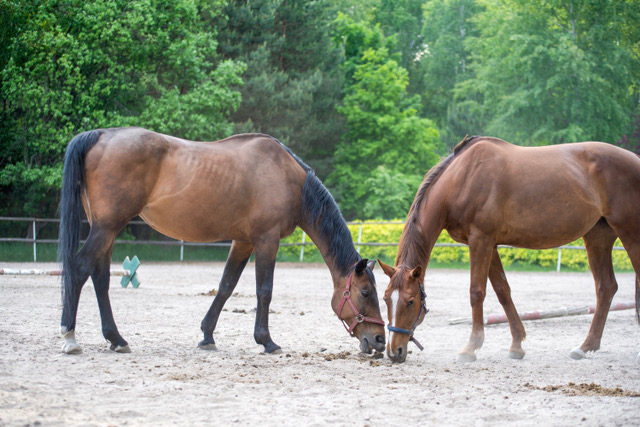Inquisitive by nature, horses often end up eating more than the forage and feed their caretakers provide for them. Horses regularly consume tree bark, leaves, soil and, perhaps most disturbing, manure. What would make a horse do this?
Coprophagy, the fifty-cent word for manure eating, is normal, especially common in young horses. Foals are thought to eat manure as a way to populate their digestive organs with beneficial microbes, particularly the cecum and large intestine, to start establishing the hindgut microbiome. This population of microbes is vital for optimal digestion of fiber and production of B vitamins, among other health-affirming roles.
Some mature horses ingest manure, too. The behavior is often associated with insufficient long-stem fiber from pasture or hay in the diet. Horses that consume low-fiber, high-grain diets or protein-deficient diets may engage in coprophagy.
When grass begins to grow in the spring, it provides abundant forage that is high in moisture and carbohydrates but low in fiber. Horses often have loose manure in the spring, indicating a disturbance in the microbiome.
In these cases, an easy dietary adjustment involves boosting consumption of long-stem forage by increasing hay intake to at least 1% of body weight per day. Horses have an innate appetite for fiber. Whether in drought or in rainy seasons, horses will consume hay or another fibrous feedstuff to satisfy their fiber requirements. When the water content of the pasture decreases and the fiber increases, horses often start leaving the hay. Offer only as much hay as the horses will eat.
The act of consuming soil is referred to as geophagia. Mineral deficiencies, particularly salt, are thought to contribute to this behavior in horses, again emphasizing the importance of ensuring the horse’s diet is properly balanced. Every horse’s diet should include salt, and often free-choice access is best. Ingested soil may also provide additional beneficial organisms to repopulate or maintain hindgut microbial populations. Consumption of clay-rich soil may have a soothing effect on an irritated stomach.
Concerns with geophagia primarily involve ingestion of internal parasite larvae and sand. If your horse frequently engages in geophagia, other management tactics might be implemented, such as increased salt intake, psyllium supplementation to remove sand, or the use of a grazing muzzle.
Horses rely on the fragile microbial ecosystem of their hindgut for optimal well-being. If that ecosystem is thrown into turmoil, through die-off of beneficial microbes or proliferation of noxious ones, gastrointestinal health can deteriorate, as can overall health. The microbiome influences several body systems through the gut -brain axis. When microbiome upset occurs, it is important to correct the situation as quickly as possible. One little-known method of repopulating the hindgut with beneficial bacteria is fecal microbiota transfer.
Fecal microbial transplant, or fecal transfaunation, involves taking feces from a healthy patient and placing it in the gastrointestinal tract of a patient with a digestive disorder, thereby introducing beneficial bacteria that, in turn, colonize the gut and rebalance the microbiome. This procedure has been performed in humans as well as horses.
In humans, the transplant is placed directly into the large intestine through a suppository, but that is difficult to do in horses due to the length of the rectum and dorsal colon. In horses, the manure is placed directly into the stomach through a nasogastric tube. The process is straightforward: fecal material from healthy horses is thoroughly mixed with water, and the mixture is then strained. The liquid fraction is tubed into the stomach of the sick horse with the assumption that some of the bacteria will make it all the way to the hindgut intact. This is one of the most useful veterinary treatments for horses that are scouring, in poor condition, or have other digestive disturbances.
How does fecal transplant differ from coprophagy in horses? It does not, proving that ingestion of manure is a natural way to populate the gastrointestinal tract with helpful microbes.
The demands placed on horses, as both athletes and breeding animals, mean that substantial quantities of energy–rich feeds are consumed and this can upset the hindgut environment. Disturbances in the normal hindgut environment are thought to result from overconsumption of either high–starch or high-sugar concentrates (causing excess undigested nonstructural carbohydrates to reach the hindgut) or pasture grasses rich in indigestible fructans (short or long chains of the sugar fructose) that are fermented in the hindgut, causing an increase in acid production. .
Hindgut acidosis leads to changes in the bacterial population of the hindgut, digestive disturbances, and reduced digestive efficiency. EquiShure features a time-released buffer to neutralize the acid and help maintain a stable hindgut environment, which encourages proper digestion and absorption of nutrients.











